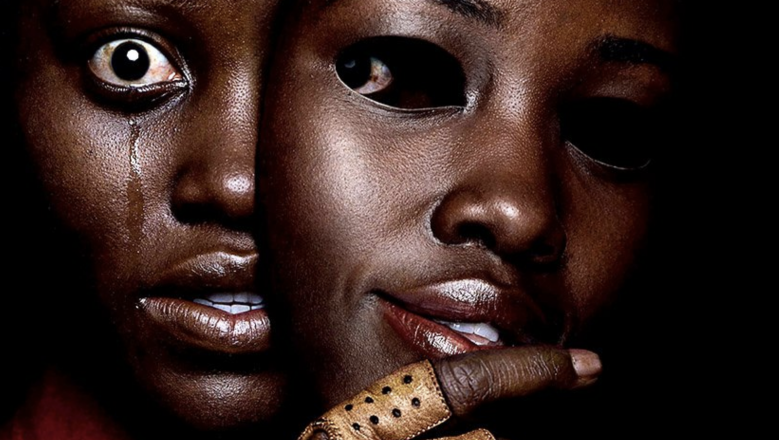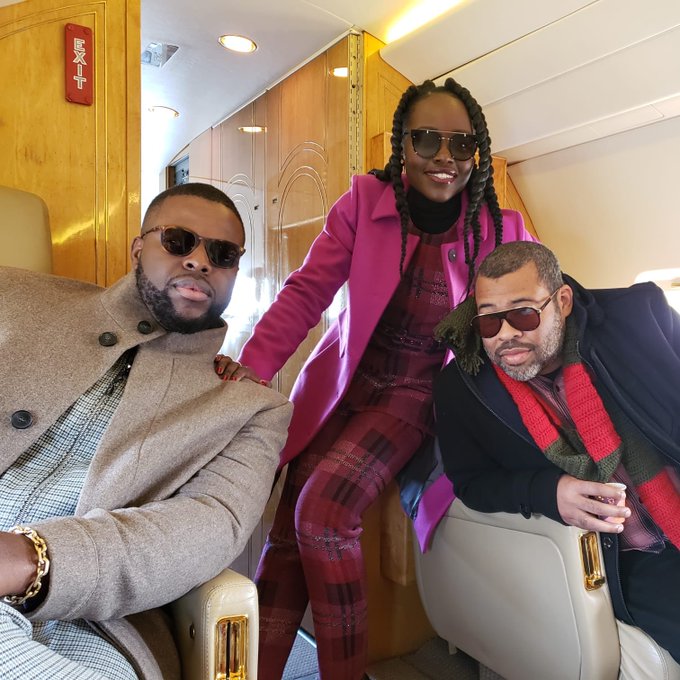
@UsMovie/Twitter Jordan Peele's "Us" is filled with symbolism and pop culture references that'll have fans dissecting it for years.
This post contains spoilers from Jordan Peele’s Us—read at your own risk!
Jordan Peele’s Us is now in theaters and it’s an absolute force to be reckoned with—a multi-layered onion that demands to be peeled and dissected. The film follows the Oscar-winning Get Out and serves as another horror-themed gateway for Peele to comment on class, privilege, and race in America while simultaneously examining the darkest sides of humanity. It’s a meaty film filled with symbolism and meaning that goes way deeper than its surface-level horror (and trust me, there are plenty of scares!).
Peele shows zero signs of sophomore slumping with this movie that’s buoyed by comedic, whip-smart writing and a dynamite cast including Lupita Nyong’o, Winston Duke, Elisabeth Moss, and Tim Heidecker.
Hidden throughout the film are tons of symbolic easter eggs and pop culture references that add layer upon layer to what we’re shown at face value. Peele himself even stated in promotional interviews that, “Everything in this movie was deliberate, that is one thing I can guarantee you.” Here are some of the more important fun-bits you may or may not have picked up on.
The VHS Tapes Next to Adelaide’s TV
Early in the film, as young Adelaide is watching TV in 1986, we see a collection of VHS tapes lined vertically, adjacent to her television set. Peele slowly zooms in on the TV, lingering long enough to let the viewers read all of the titles. Knowing how Peele operates, we know each and every one of those cassettes was craftily hand-selected.
The Goonies: A seminal classic from the ’80s, The Goonies chronicles an underground adventure as a group of kids hunt treasure in the tunnels and shafts below their small town. In Us, Red, one of “The Tethered,” paraphrases a line from the film for her big speech in the movie’s climax. “It’s our time now. Our time, up there.” Mikey Walsh would be proud.
C.H.U.D.: This 1984 cult sci-fi/horror film tells the story of cannibalistic humanoid underground dwellers who live underneath New York City’s sewers. In Us, an eye-witness states on the news that “Someone said they were coming from the sewers,” similar to Us‘s Tethered beings from below. Aside from that, Peele also has a very personal connection to the film; his first girlfriend’s father directed C.H.U.D., as he revealed in an interview with Polygon.
The Man With Two Brains: The 1983 Steve Martin comedy about a scientist who falls in love with a talking brain is also loosely related to Peele’s original story, at least thematically as he told Uproxx. “The idea of two intelligences sharing a soul in a way…and was probably a little reference to Get Out in there too.”
A Nightmare on Elm Street: It’s not just Peele’s own outfit choices (see below), but there are multiple references to Wes Craven’s 1984 horror classic, including the Freddy Krueger-like burns on Pluto’s face; the Tethered’s single, brown glove; and also Adelaide’s trip through a boiler room, calling out where Freddy took his victims before he became a…nightmare on Elm St. I wouldn’t be surprised if repeated viewings reveal even more Nightmare references, as Peele is a huge fan of Robert Englund’s Freddy.
The Right Stuff: This one left me clueless, but there has to be a reason Peele included it. If you have any ideas, let me know!
The Work of Brian De Palma and Stanley Kubrick
From a director’s standpoint, Peele pays homage to the work of De Palma and Kubrick in many ways that are subtlely sprinkled throughout the film. For starters, there are lots of similarities between Us and Kubrick’s Stephen King adaptation, The Shining. Aerial shots of the family driving in their car on an empty road mirror the Torrance family’s trip to the Overlook Hotel. (Peele uses shots like these in the beginning and end of Us.) There’s also the annoyingly creepy twins in Us, an obvious trope thanks to The Shining, who deliver a ton of mid-movie jump scares. Then there’s the use of a baseball bat as a makeshift weapon. Both Wendy Torrance and Us‘s Gabe swing for the fences to protect their families with little success—but hey, at least we aren’t left screaming, “FIND A WEAPON, WHAT ARE YOU DOING?!” from our theater seats, so points for that!
De Palma’s influence can be seen in one particular fascinating (and quite beautiful) scene toward the end of the film. Peele uses a split diopter shot during the classroom climax featuring Adelaide and her Tethered counterpart, Red. Both characters are in sharp focus despite standing on opposite sides of the room—a shot that is renowned to be in De Palma’s playbook. Also noteworthy, De Palma’s 1972 film Sisters tells the story of a woman and her murderous, evil twin. Us plays on yin-yang counterparts, on good vs. evil, whenever it can, and Peele never hesitates to tip his hat toward many of the classic directors who came before him.
The Lost Boys
You can’t have a scene on the Santa Cruz pier and not reference Joel Schumacher’s 1987 vampire flick The Lost Boys. “They’re filming something by the carousel. You should see if they’re looking for extras,” Adelaide’s mother tells her father in the opening 1986 boardwalk scene. The Lost Boys filmed on that very boardwalk in 1986 placing Peele’s characters in the same world as Schumacher’s production, which Peele confirmed in an interview. (This really tickled the Lost Boys nerd in me.)
Jeremiah 11:11
In the film, young Adelaide walks by a homeless man holding a sign with a Bible verse written on it. We see that man again at the end of the film only this time, he’s dead, having been killed by his doppelgänger, and the verse is carved across his forehead.
The passage revolves around God’s warning to the Jewish people as to what will happen if they keep worshipping false idols. It reads:
“Therefore thus saith the Lord, Behold, I will bring evil upon them, which they shall not be able to escape; and though they shall cry unto me, I will not hearken unto them.”
It could be argued that the verse is a warning from the Tethered to the people above; Red clearly states that she doesn’t believe the people above deserve the privileges they’ve been rewarded with, therefore, the Tethered have begun to “bring evil upon them.”
The number also appears elsewhere in the film, like on Jason’s clock in his bedroom right before their electricity kicks the bucket and the family’s evil twins attack.
Hands Across America
Early in the film, young Adelaide is watching a Hands Across America commercial on TV. For those who weren’t around then or simply can’t recall, Hands Across America was a charity event created by Ken Kragen (the guy behind “We Are the World”) with the intention of raising money to cure hunger. The event aimed to connect all citizens of America by physically linking them hand-to-hand in a chain. While it did raise $15 million nationwide, it fell far short of its lofty goals.
“Hands Across America was this idea of American optimism and hope, and Ronald Reagan-style-we-can-get-things-done-if-we-just-hold-hands,” Jordan Peele told Vanity Fair. “It’s a great gesture—but you can’t actually cure hunger and all that.”
Young Adelaide can also be seen wearing a Hands Across America shirt, and later, the Tethered are seen in a sweeping aerial shot all holding hands for miles and miles.
Vulture has an incredible deep-dive into this failed fundraiser if you want to learn more.
Alice in Wonderland
One of the more obvious references harks to Lewis Carroll’s Alice in Wonderland. We see bunnies in cages in the opening credits, and later, rabbits roam, hop, and flock in the underground quarters housing the Tethered. As the grown-up Adelaide re-enters the creepy hall of mirrors, she goes deeper and deeper down the rabbit hole as she heads toward facing the truth about her own existence and the horrors she’s been experiencing. It’s essentially her own version of the Looking-Glass.
The rabbits, which also serve as raw and bloody food for the Tethered, also present a theme revolving around freedom. The rabbits at the end are running “free,” finally out of the cages that contained them, but they’re just as trapped below ground as the Tethered who eat them. But if two beings share one soul, as the film presents, then why does one being deserve the freedom of the world, while the other is caged below ground, hopping around like rabbits waiting to die. How can one be granted with certain rights the other half doesn’t have? Who makes that call? This is one of the many questions the film raises that can be directly applied to our own society today.
Us is a film that is jam-packed with symbolism, references, thematic expressions, and real-life issues that are all analyzed through a horrifying lens. It presents an Us-vs-Them dichotomy with each side having a myopic viewpoint of how things should be, what human rights we deserve, and whether or not we should share those privileges with others. While one can certainly enjoy Us as a surface-level source of horror entertainment, it’s a fascinating movie to dissect, one that will no doubt deliver more and more questions and views with each and every rewatch.
READ NEXT: ‘Us’ Movie Ending & End Credits: Is There an After Credit Scene?
